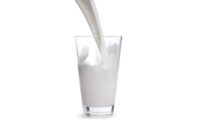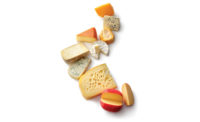It’s no secret that per-capita liquid milk consumption has been on the decline in the United States for many years. In fact, Americans consumed 93 pounds less of the dairy beverage in 2016 than they did in 1976, according to data from the USDA.
Milk | Cheese | Cultured | Ice Cream | Butter | Non-dairy Beverages | Ingredients | Exports
But positive news can be found in some fluid milk segments. Data from Chicago-based market research firm Information Resources Inc. (IRI) show that dollar sales within the retail refrigerated whole milk subcategory rose 3.9% to reach $4.8 billion during the 52 weeks ending Aug. 6, 2017. Unit sales climbed 3.7% to 1.7 billion.
During the same timeframe, dollar sales within the refrigerated flavored milk, eggnog and buttermilk subcategory increased 3.2% to $1.5 billion. Unit sales rose 2% to 697.3 million.
But sales within the reduced-fat milk sector continued to slide downward. Dollar sales for refrigerated skim and reduced-fat milk fell 6.0%, IRI data show, while unit sales saw a 5.6% decline. In terms of overall sales, however, this segment — with dollar sales of almost $8 billion and unit sales of 2.9 billion — still dwarfs both of the aforementioned categories.
Consumers want simplicity, ‘extras’
The good news going forward is that milk fits in well with consumers’ shifting preferences, which are trending toward the simplicity of earlier times.
“Everything old is new again,” said Kurt Laufer, chief customer, marketing and innovation officer for Dallas-based Dean Foods. “Consumers are again appreciating milk for its clean label, nutritional value and fresh positioning. There also continues to be a consumer shift back to whole milk.”
Julia Kadison, CEO of the Milk Processor Education Program (MilkPEP), agrees that milk is in line with what consumers want.
“Today’s consumer is obsessed with picture-worthy, ‘Instagrammable’ food and seeks to fully understand the food they choose — where it comes from, how it’s made and even who made it,” she said. “Our food culture has evolved, and milk is totally aligned with the values today’s consumer seeks — especially when it comes to the whole farm-fresh, farm-to-table trend.”
When it comes to milk, consumers also value local, said Chris Keyes, vice president of sales strategy for Dairy Farmers of America (DFA), Kansas City, Kan.
“At DFA, we are committed to continuing the support of our local and trusted milk brands to meet these articulated consumer needs,” he said.
With its health halo, milk fits in with the all-encompassing health and wellness push, too. Still, consumers’ definition of healthful food and beverages is changing, Paul Ziemnisky, senior vice president of global innovation partnerships for Rosemont, Ill.-headquartered Dairy Management Inc. (DMI), points out.
“They are looking for more protein and less sugar,” he said. “fairlife tapped into this consumer insight and is on pace to become a $250 million brand in only its second year.”
In line with the clean-label trend, many consumers also are seeking out non-GMO milk and organic milk. And despite the current excess supply environment, rising demand points to a bright future for the U.S. organic milk industry. This has led a record number of dairies to transition to organic milk production, according to a 2017 report from Greenwood Village, Colo.-based CoBank.
Consumer demand for on-the-go beverages is strong, too. Ziemnisky said dairy brands have responded by launching more dairy-based ready-to-drink (RTD) options. For example, Shamrock Foods Co. recently debuted Shamrock Farms Cold Brew RTD milk-and-coffee beverages.
Consumers, especially millennials, increasingly want an emotional connection with the brands and products they buy, too, noted Eric Snowdeal, senior brand manager for Organic Valley, La Farge, Wis.
“Processors are updating their packaging and telling their story to meet the needs of the valuable millennial consumer,” he said.
Artisan/craft-type products boast appeal here, said Siva Kaliappan, vice president of product research for the National Dairy Council, adding that some brands are producing milk in small batches and using premium packaging, including glass.
“These companies also offer limited-edition flavors such as root beer, blueberry, maple, salted caramel, orange cream and others,” Kaliappan said.
New products deliver
Not surprisingly, much of the recent new product development on the milk side aims to address the preferences of today’s consumers.
For its part, Dean Foods recently reformulated its TruMoo flavored milk line with non-GMO ingredients. And this past summer, Organic Valley added the sweet cream flavor to its lineup of Organic Valley flavored organic half & half.
Also adding to the organic milk assortment this year was Straus Family Creamery, Petaluma, Calif. The company debuted Straus Family Creamery organic chocolate milk — made with on-trend whole milk and sold in reusable glass 32-ounce bottles. The product is made with only five ingredients: homogenized organic whole milk, organic cane sugar, Fair Trade-certified organic cocoa powder, organic vanilla extract and a lactase enzyme.
On the higher-protein front, Chicago-based fairlife introduced fairlife SuperKids, a line of protein-packed milks marketed to children. The milks come in whole, 2% reduced-fat or fat-free plain ultra-filtered milk, and 2% chocolate ultra-filtered milk varieties.
And Organic Valley recently extended its Organic Fuel RTD line to include powder. Made from organic whey protein powder, the product contains 26 grams of protein and only 3 grams of sugar.
On the artisan/flavored milk front, The Farmer’s Cow, Lebanon, Conn., recently added raspberry white chocolate to The Farmer’s Cow line of
limited-edition flavored milks this past spring — in a 32-ounce collectible glass bottle. Earlier in the year, the company introduced limited-edition maple and blueberry flavored milk offerings.
And in September, Johnstown, Pa.-based Galliker Dairy introduced a limited-edition pumpkin pie-flavored milk for the fall season. Made with milk and a pumpkin pie base, the milk retails in a grab-and-go pint-sized bottle.
Meanwhile, DanoneWave’s WhiteWave Foods, Broomfield, Colo., launched Sir Bananas low-fat milk. Boasting real banana puree, the half-gallon product comes in banana and chocolate-banana varieties.
WhiteWave Foods also added a new flavor, Sweet & Creamy, to its International Delight Simply Pure line of clean-label flavored coffee creamers. The creamer, introduced in January, is said to be made with real milk and four other simple ingredients.
In addition, the company debuted an innovative dairy-based coffee creamer in a pressurized can. International Delight One Touch Latte allows consumers to create a latte-style coffee drink at home. The creamer comes in three flavors: mocha, vanilla and caramel.
Opportunity knocks
To reverse the multi-year downward trend within the overall milk category, milk processors will need to transform the segment’s many challenges into opportunities. One such challenge is the growing abundance of refrigerated dairy-alternative beverages.
“Unlike their center-store counterparts, refrigerated dairy-alternative beverages — think almond milk and novel blends — have the advantages of both refrigerated formulation and a familiar gable-top carton, said the Packaged Facts division of Rockville, Md.-based MarketResearch.com in a press release for its August 2017 white paper titled “Terminology Tempest in the Dairy Case.”
But Kaliappan said dairy brands could help address this challenge by highlighting the components of milk — such as protein — that fall in line with consumer wants and needs.
Laufer agrees that more consumers are gravitating toward milk alternatives, but also noted that consumers are seeking out organic milk options. Dean Foods is engaged in efforts to turn these realities into positives for the company.
“Dean Foods partnered with Organic Valley to form a joint venture where the Dean Foods manufacturing plants and DSD route system produce and distribute fresh Organic Valley milk,” he said. “We also made a minority investment in Good Karma, a flaxseed-based milk alternative for people with dairy, nut or soy allergies.”
Consumption losses tied to fat-free milk also are an issue, Keyes noted.
“As an industry, we need to look hard at that segment and determine how we can retain and grow consumers in that fat level,” he said.
Keyes added that MilkPEP has done a good job of building demand for flavored milk over the past three years and is confident that its Milk Life campaign will result in a consumption lift for white milk, too.
With so much information coming at parents across channels ranging from TV to social and digital, conflicting information also presents a potential roadblock to increasing consumption among children. Yet kids present a significant growth opportunity.
“Some of the negative messages they hear about milk are eroding where milk stands, particularly in moms’ minds,” Kadison noted. “We know moms go to social media channels and influencers to seek out information about what to feed their kids. And we can — and do — use these same channels to remind her of all the ways milk is so relevant to her life — from reminding her how much her kids love milk and how good it is for them, to showing milk in her favorite recipes, to featuring milk alongside elite athletes competing for Team USA. Our job is to make sure moms trust milk — help her sort through the negative misinformation she’s hearing.”
Another challenge can be found in oversupply — too much milk and a shortage of cream, Snowdeal pointed out.
“Consumers have shifted their preference from skim and low-fat milk products to reduced-fat and whole, which has exacerbated the situation,” he said. “Our cooperative is working hard to make sure we don’t waste any milk, while protecting our family farms. It’s not easy and will take several more months, but eventually it will balance out again.”
Opportunity also could be found via continued product innovation, of course. For example, combination milk and coffee products already can be found in the marketplace, but dairy processors could raise the innovation bar by playing with milk’s composition via filtration technology — enhancing protein content, increasing calcium, reducing sugars and more, Kaliappan said.
Other technology enhances hot beverages’ protein stability, allowing processors to capitalize on dairy’s unique protein properties and cater to the needs of casual and serious athletes, he suggested.
“We’re seeing success already with refuel milks such as Core Power and Rockin’ Refuel,” Kaliappan noted. “There also are opportunities to formulate milk with new international and ethnic flavors that appeal to a younger generation of consumers who have moved away from dairy consumption.”
Milk | Cheese | Cultured | Ice Cream | Butter | Non-dairy Beverages | Ingredients | Exports









